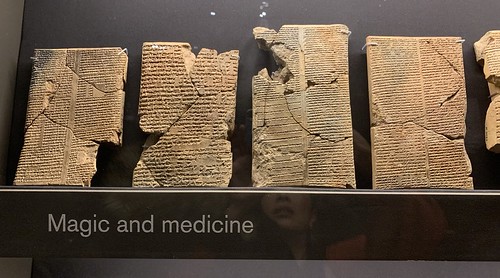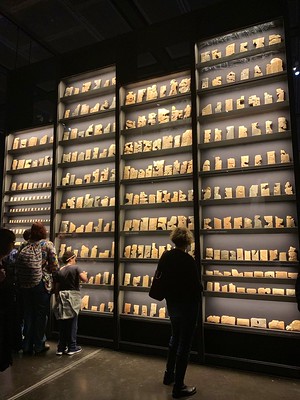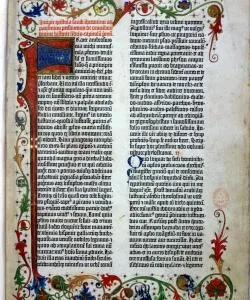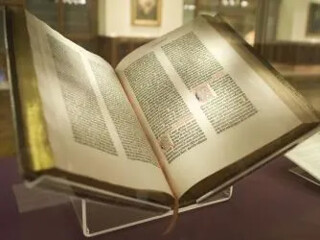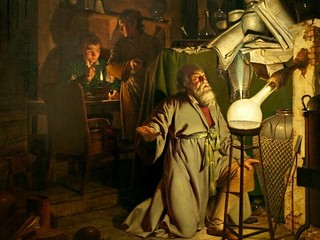
PREV ARTICLE
NEXT ARTICLE
FULL ISSUE
PREV FULL ISSUE
V25 2022 INDEX E-SYLUM ARCHIVE BOOK NOOK: OCTOBER 2, 2022There were several items in the media this week relating to books, so I thought I'd group them together here for our bibliophiles. -Editor In the now-THAT'S-a-slabbed-collectible department, here's an article about the University of Chicago's attempt to study what is purported to be a 26-page booklet encased in concrete. -Editor Art historians enlisted the help of Argonne National Laboratory to study artist Wolf Vostell's Betonbuch (Concrete Book). THE SLAB OF CONCRETE IS more than a foot tall, ten inches wide, and two inches thick. It weighs about 20 pounds, and it is cataloged in the University of Chicago's library system as a book.
This unusual tome, titled Betonbuch (Concrete Book), was
The University of Chicago has long owned one of Vostell's best known concretifications, Concrete Traffic. It is, unmistakably, a car covered in concrete—specifically, a Cadillac deVille drowned in a quickly hardening sand-and-stone slurry in a busy commuter parking lot in Chicago one morning in 1970. But when the university acquired copy number 83 of Vostell's Betonbuch in 2016, Patti Gibbons, head of collections management for the Hanna Holborn Gray Special Collections Research Center, began to wonder:
To read the complete article, see:
Here's a story about Ashurbanipal's Great Library, the oldest surviving royal library in the world. -Editor Ashurbanipal's Great Library is the oldest surviving royal library in the world. The library consisted of a collection of clay tablets made, covered in fine writing and pressed together on both sides. Up to 30,000 tablets and fragments containing texts of all kinds from the 7th century BC, including texts in various languages, were collected, found under the rubble of the royal palace at Nineveh. One of the most famous works in the library is the Epic of Gilgamesh, considered to be the oldest narrative work of mankind.
Ashurbanipal ruled with an iron fist, but never engaged in battle. Hence, many historians catalog him as a "sociopathic bookworm" who pulled the strings from the capital of the empire, in Nineveh (which gives its name to a current city located in Iraq). From this city he showed his cruelty without having to lead his troops in the fights himself. He preferred to be an opulent leader. In several of the reliefs that formed part of the walls of the palace of this monarch, he is shown hunting lions to show that no beast could conquer him. But his scholarship crossed borders and Ashurbanipal collected thousands of works written on sheets of clay. Much of the library (in which he preferred to remain secluded) that he assembled is a perfect example of the level of knowledge of the Assyrian empire, the value of education to his kingdom, and the power he wielded during that period of time. All combined made Assyria a region that, according to experts, was "magnificent, innovative and interesting." Ashurbanipal was a complex and often misrepresented figure.
To read the complete article, see:
This article links to videos with more information on each of the titles. Some familiar names here like the Gutenberg Bible and The Codex Leicester, plus a few that may be surprises. -Editor
These are ten of the rarest books in history. They are rare because the author decided to print a smaller number of copies, copies got lost to history, etc. In any case, all of the books on our list today have two things in common: They are historically or culturally significant and extremely hard to find.
To read the complete article, see:
Speaking of the Gutenberg Bible, The Writer's Almanac for Friday, September 30 noted the anniversary of its first finished section. -Editor
Ancient books had primarily been written on scrolls, though an innovation in the second century A.D. — that of the codex, a sheaf of pages bound at one edge — gave us the familiar book form we recognize today. Early codices were produced by hand by monks in scriptoriums, working with pen and ink, copying manuscripts one page at a time so that even a small book would take months to complete and a book the size of the Bible, rich with color and illuminations, would take years. Gutenberg's genius was to separate each element of the beautiful, calligraphic blackletter script commonly used by the scribes into its most basic components — lower case and capital letters, punctuation, and the connected ligatures that were standard in Medieval calligraphy — nearly 300 different shapes that were then each cast in quantity and assembled to form words, lines, and full pages of text. He also invented a printing press to use his type, researching and refining his equipment and processes over the course of several years. Only four dozen Gutenberg Bibles remain, and of these only 21 are complete, but what Gutenberg created went far beyond the reach of those volumes. By beginning the European printing revolution, he forever changed how knowledge was spread, democratized learning, and allowed for thoughts and ideas to be widely disseminated throughout the known world. In his time, Gutenberg's contemporaries called this "the art of multiplying books," and it was a major catalyst for the Renaissance, the Scientific Revolution, and even the Protestant Reformation. In 1997, Time magazine named Johannes Gutenberg "Man of the Millennium" and dubbed his movable type as the most important invention of a thousand years.
To read the complete article, see:
To paraphrase an old rock song, "Out there is knowledge waiting to be had - if you think I'll let it go, you're mad - you've got another thing coming." -Editor In one of my favorite scenes from the movie Seven, Morgan Freeman's character gets a guard to let him into a library late at night so he can conduct research. While the five members of the library's night staff are sitting around a desk playing cards he says to them:
This scene might serve as a fitting summary of our current culture. At least, that's the implication in a recent Baffler article titled So we are confronted with the situation of a rise in the potential for self-education (in the form of increased access to books, internet resources, MOOCs, etc.) with a decline in autodidacts. Why is that? In school, students are not rewarded based on how deeply they have assimilated knowledge, and how much this knowledge has improved their character. Rather, they are rewarded for how well they have played the game and jumped through the hoops—they are rewarded based on how high their GPAs are, how many AP classes they have taken, and how many extracurricular activities they have accumulated. With very few exceptions, your ticket onto a successful career path is not your demonstrated knowledge, ability, and potential; it's how high of a college degree you have, and even more importantly, where you got that degree.
To read the complete article, see:
Books about booksellers and collectors are a classic subgenre. A new one is coming from a young author at Henry Sotheran in London. Maybe not all youth is indifferent to knowledge. -Editor
Darkshire runs the firm's Twitter account (@Sotherans) which has attracted more than 41,000 followers
To read the complete article, see:
This article is from 2020, recommending books with themes related to famous Twilight Zone episodes. -Editor Here, weary traveler, you find yourself with your back to the closed door of the Twilight Zone. In front of you now there are thirteen doors with unknown horrors and unsolved mysteries that await. It is, like the land you have come from, a realm of shadow and substance both, fueled by imagination. You have entered a world where people will come alive from the page, where their stories will trod behind you for the rest of your days.
To read the complete article, see:
Another Writer's Almanac for September 28th discusses the real and fictional bookseller Nicholas Flamel. -Editor
Flamel is said to have come into possession of curious book, which he bought for two florins from a stranger who'd come to his bookstall in need of money and with a manuscript to sell. The book was bound in worked copper, engraved with curious symbols and characters, its 21 leaves made of the bark of young trees and inscribed with a sharp metal point, and even a seventh leaf illuminated with the picture of a serpent, or serpents: swallowing swords, crucified on a cross, and trailing from a bubbling fountain in the middle of a treeless desert. This was the Book of Abraham the Jew, and it contained a complete exposition on the art of transmuting base metal to gold, using the legendary philosopher's stone, and the means by which one could distill from the stone the Elixir of Life and extend human life indefinitely. A new generation has been introduced to Nicholas and Perenelle Flamel, who were close friends of Albus Dumbledore, wizard and headmaster of Hogwarts School of Witchcraft and Wizardry, where Harry Potter and his friends attended school. In the first book of the series, The Sorcerer's Stone, the Flamels were in their upper 600s, living in Devon and kept immortal by regular infusions of the Elixir of Life, but were forced to destroy their philosopher's stone to keep it from the clutches of the dark wizard Voldemort and so, finally, passed away.
To read the complete article, see:
For more on Flamel and the Philosopher's Stone, see:
Wayne Homren, Editor The Numismatic Bibliomania Society is a non-profit organization promoting numismatic literature. See our web site at coinbooks.org. To submit items for publication in The E-Sylum, write to the Editor at this address: whomren@gmail.com To subscribe go to: https://my.binhost.com/lists/listinfo/esylum All Rights Reserved. NBS Home Page Contact the NBS webmaster 
|

